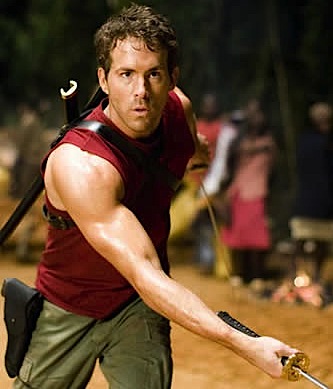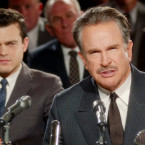News & Notes Inside the Week in Film
Here’s the Kick(start)er
Everyone (read: Kristen Bell and Zach Braff) is turning to Kickstarter to raise funds for their film projects. Is this the new model for funding? The answer is no. But it does mean something. Chris Neumer investigates the something.

by Chris Neumer
In the last few weeks, Kickstarter (.com) has made headlines by enabling Kristen Bell (and Veronica Mars creator Rob Thomas) and Zach Braff to raise nearly $8 million dollars for two upcoming projects of theirs; a Veronica Mars movie and a kind of, sort of sequel to Garden State respectively. Though the specific whys and hows of each project are different, in the broad spectrum they are very similar: both Bell and Thomas and Braff headed to Kickstarter to try to raise funding for their projects outside of the studio system. And they both got it in spades. Bell and Thomas asked for $2 million and got $5.7 million; Braff asked for $2 million and got about $2.5 million.
Naturally, these two success stories have garnered a lot of play in the media, first when writers began decreeing that Kickstarter was the new way that Hollywood was going to fund its movies—it’s not—and second when writers began tearing into Braff (and to a much less extent Bell and Thomas) for having millions of dollars stockpiled away and still feeling the need to ask other people for money to finance his project. As if it even needs saying, both are a product of the 24-hour news cycle and the “new” media.
Lost in this hyperbole are two lessons that couldn’t be farther apart from one another. 1) A lot has changed with the emergence of Kickstarter, and 2) Absolutely nothing has changed with the emergence of Kickstarter. Now that we’ve got that covered, let’s delve into some details.
LESSON #1: A LOT HAS CHANGED WITH THE EMERGENCE OF KICKSTARTER
For years, filmmakers have dreamed of finding an alternative method of funding their projects beyond the two ways that have been around since the early 20th century: studios and rich guys who are looking to get into producing. Prior to 2010, those were your options. If a studio wasn’t interested, you had to find someone with a lot of cash burning a hole in his pocket. While technically there are other options to fund a project—director Justin Lin financed his first project, Better Luck Tomorrow, by maxing out 12 different credit cards—they are so mind-bogglingly risky and so incredibly short-sighted, that they probably shouldn’t be mentioned. Kickstarter and other crowd funding (or crowd sourcing) platforms have changed that. No longer do would-be filmmakers need access to studios or men like Scrooge McDuck or the Monopoly Man to raise cash for their movies. Now they can go directly to the people and gain funding for their projects ten dollars or thirty dollars at a time. This is absolutely amazing! But it also brings us to…
LESSON #2: ABSOLUTELY NOTHING HAS CHANGED WITH THE EMERGENCE OF KICKSTARTER
 The problem with this nickel and dime approach to fund raising is that it doesn’t bring in a lot of money unless a lot of people get involved. If you hoped to raise a million dollars to shoot a film on Kickstarter—a ridiculously miniscule amount of money for a legitimate project—that breaks down to 100,000 people donating $10 a piece to you over the course of a month. And, when you put it like that, it doesn’t seem especially feasible. Getting 500 people to give you $10? That seems doable. 100,000? Not so much.
The problem with this nickel and dime approach to fund raising is that it doesn’t bring in a lot of money unless a lot of people get involved. If you hoped to raise a million dollars to shoot a film on Kickstarter—a ridiculously miniscule amount of money for a legitimate project—that breaks down to 100,000 people donating $10 a piece to you over the course of a month. And, when you put it like that, it doesn’t seem especially feasible. Getting 500 people to give you $10? That seems doable. 100,000? Not so much.
The reason that Bell and Thomas and Braff are making waves with their Kickstarter campaigns is because people already know them. I hope you’re sitting down, but celebrity sells. Bell, Veronica Mars and Braff are very well known brands at this point. That is why they’re able to raise the millions of dollars they have. Bell and Braff have a shockingly large and similar number of twitter followers, 1,084,787 for Braff and 1,084,743 for Bell. If just one out of ten of their followers donated $10, they’d have a million dollars. (Thomas has just 38,000 followers; the math for him is not pretty).
In short, the reason that Bell and Braff got their money isn’t because of the new platform, it’s because they’re famous. Sure, it was on a new platform, but, when you think about it, famous people getting money to make movies isn’t exactly the kind of ground breaking news this story was made out to be.
Sadly, while this new crowd funding platform appears like it could be a boon to independent filmmakers (and is certainly being written about as such), it’s only a matter of time before some figures out how to make it morph into a variety of the system that is currently in place. Allow me to explain.
As of this writing, there are 981 entries into the Film & Video portion of Kickstarter. That is a lot of entries to sift through. Someone, somewhere is going to realize that he can become a mini-mogul simply by telling people which movies they should put their money in. The same way that Oprah encourages people to read by including new books into her book club, this enterprising fellow would encourage people to donate money to projects by getting his seal of approval. Once this name X is branded and then attached to different projects attempting to get crowd funding, it will make things a lot better… at least for the people whose projects have gotten the seal of approval.
The other aspect of crowd funding that I find interesting is the way that Kickstarter is allowing consumers to pay for the type of entertainment they want.
The new Veronica Mars movie is getting made because people want to see it. If David Simon decided to try and make a continuation of The Wire, he might end up testing the capacity of the Kickstarter servers. Same holds true if Judd Apatow ever decided to try to raise money to make a Freaks & Geeks movie or if Joss Whedon wanted to reboot Firefly. Right now, somewhere in southern California, Arrested Development creator Mitch Hurwitz is kicking himself and wondering why Kickstarter couldn’t have been around in 2006; it would have saved the show and probably transformed the entertainment industry as we know it (more on this in a future column).
 And while on the outset, the concept of consumers paying to see the type of movie they want to see seems like a continuation of capitalism and the way society has operated since the dawn of time, there is a slight deviance from that here that changes things. Instead of choosing between three movies that are out at theaters and paying to see one, people are now choosing which movies end up getting made in the first place. The choosing process is happening much, much earlier in the process; frankly, it seems ripe for lowest-common-denominatoring. I’d like to think that movies like Lincoln and The Life of Pi would still get made if Hollywood adapted this style of funding industry-wide, but I can’t say that I’d bet a lot of money on it.
And while on the outset, the concept of consumers paying to see the type of movie they want to see seems like a continuation of capitalism and the way society has operated since the dawn of time, there is a slight deviance from that here that changes things. Instead of choosing between three movies that are out at theaters and paying to see one, people are now choosing which movies end up getting made in the first place. The choosing process is happening much, much earlier in the process; frankly, it seems ripe for lowest-common-denominatoring. I’d like to think that movies like Lincoln and The Life of Pi would still get made if Hollywood adapted this style of funding industry-wide, but I can’t say that I’d bet a lot of money on it.
In the end, everything would probably work itself out and there would be a niche for smaller, art driven projects as there is now, but it is an interesting semantic debate to have ala donating money to news organizations that report from a perspective that you agree with.
This story is far from over and I will be curious to see what twists and turns lie in store for us. In the meantime, we can look forward to a Veronica Mars movie and a sequel to Garden State. Um, thank you, Kickstarter?
Just Asking…
WHAT IS THE FASCINATION WITH MAKING SUPERHERO FILMS ABOUT SUPERHEROES WHO HAVE ALREADY BEEN KILLED?
by Chris Neumer
 It started when Sony announced plans for a spin-off movie about Spider-Man’s adversary, Venom. The new project, titled of all things, Venom, is currently in development. The move was peculiar in that Venom had made a brief appearance in 2007’s Spider-Man 3 and, during that brief appearance, he had been killed. And Venom hadn’t just been killed, he had been killed in a manner that left no doubt that he had been killed. He’d been incinerated.
It started when Sony announced plans for a spin-off movie about Spider-Man’s adversary, Venom. The new project, titled of all things, Venom, is currently in development. The move was peculiar in that Venom had made a brief appearance in 2007’s Spider-Man 3 and, during that brief appearance, he had been killed. And Venom hadn’t just been killed, he had been killed in a manner that left no doubt that he had been killed. He’d been incinerated.
And it continued when Fox announced plans for a spin-off movie about Wolverine’s adversary, Deadpool. The new project, titled of all things, Deadpool, is also currently in development. This move was peculiar too in that Deadpool had made a brief appearance in Wolverine and, during that brief appearance, he had been killed. And Deadpool hadn’t just been killed, he had been killed in a manner that left no doubt that he had been killed. He’d been sliced into multiple parts.
I understand the appeal of making films that have a built in audience. Built in audiences mean bigger box office takes and more money for the studios. It’s very simple. However, what I don’t understand is how audiences are supposed to be interested in watching the exploits of a heretofore minor character who has already been killed on-screen. We’ll leave my confusion about watching a movie featuring a bad guy as the lead alone for another paragraph.
It’d be one thing if the characters were extremely interesting and their stories were compelling—if someone wanted to make a film about The Usual Suspects’ Dean Keaton or The Lord of the Rings’ Gandalf, I’d ask where I’d have to line up to see it and for how long I’d have to camp out in order to get a ticket—but Deadpool and Venom aren’t exactly knocking on the door of AFI’s Best Characters list. In Deadpool’s case, his lips have actually been sewn shut so that he can’t talk. In Venom’s case, I’m not sure whether the villain is the man inside the suit or the suit itself. Either way, it’s hard to understand this logic.
Oh yeah, and both of them have already been killed! It was Spider-Man vs. Venom and Wolverine vs. Deadpool. We cheered on the forces of good and waited with bated breath to see if Spider-Man and Wolverine was come out victorious. When they did, we sighed in relief and were happy to know that the good guys came out on top. Deadpool and Venom got what was coming to them. Studio executives are now banking that America’s collective memory is as short as Michael J. Fox and that no one will have a problem A) rooting for the bad guys to win or B) siding with characters who don’t just turn to evil in the future, but who turn so evil that we start actively hoping that they are soon killed.
Would it have been too much to ask to just not kill Venom or Deadpool in the movies in which they made their first appearances? I mean, really?
The Photo of the Week
Mystery Starlet

I saw these photos of this woman online this week* and absolutely could not believe it. I mean, everything Amanda Bynes does gets headlines, but this incredibly well known celebrity is photographed looking nothing like herself and no one says anything. I would estimate that this woman is one of the 25 most famous people in North America, she is worth several hundred million dollars, is a tabloid fixture and even though I know who it is, I still can’t believe it while I’m looking at her pictures. It’s unbelievable that this is Miley Cyrus. Oh, yes.
* UPDATE: These photos, while they ran with a current story, were originally taken in 2012.
The 5 Things I Learned This Week
Fascinatingly true things to broaden your mind
1) Tom Cruise credits Will Smith’s music with getting him through the ordeal of Born on the 4th of July. That was in Smith’s “Parents Don’t Understand” phase too… Just when you thought Cruise couldn’t get much more peculiar.
2) The fourth best selling issue of People Magazine was the Selena memorial issue.
3) A Very Harold and Kumar Christmas features not one, but two characters who are credited as ‘Topless Angels’.
4) Cedric the Entertainer has played characters named Maintenance Man, Scribble, Clyde Stubb, Cousin Jericho, Nighthawk Bob Terry, Golly the Goose, Bobby Proud, Sin LaSalle, Gus Petch, Reverend Beverly H. Hooker and Bo.
5) The world record for highest vertical leap is 60 inches.
This Week’s Stories
- The New Film Funding Craze: Kickstarter
- Just Asking: Why Do They Keep Greenlighting Superhero Movies where the Superheroes Have Already Been Killed?
- New Releases
- The Photo of the Week
- Trivial Fascinations: The Five Things I Learned This Week
New Releases
Broken City
 THE PLAYERS: Starring Mark Wahlberg, Russell Crowe, and Catherine Zeta-Jones; written by Brian Tucker; directed by Allen Hughes. Released by 20th Century Fox. Rated R.
THE PLAYERS: Starring Mark Wahlberg, Russell Crowe, and Catherine Zeta-Jones; written by Brian Tucker; directed by Allen Hughes. Released by 20th Century Fox. Rated R.
THE PLOT: The mayor of New York City (Russell Crowe) hires a detective (Mark Wahlberg) to follow his wife (Catherine Zeta-Jones) to find out who she’s having an affair with. Problems ensue.
THE SKINNY:
– The only thing more ridiculous than Russell Crowe’s American accent is his hair cut. Bangs? Really?
+/- Though this movie is set in the present, the whole thing has a 1960s feel to it. I have no idea whether this is a good or bad thing. I’m sure the marketing department would argue that means it’s timeless; I’m leaning towards dated.
– This is an incredibly minor point, but Mark Wahlberg plays a cop cum private investigator named Billy Taggart. This is a combination of the two Beverly Hills Cop police officers Billy Rosewood and John Taggart. Whether or not this was the genus of the name, it’s what we got. For the same reason that calling a character Cameron Bueller or Kermit Piggy or Brock Diggler might confuse someone or take him out of the moment, so did calling the Broken City lead Billy Taggart. Every time anyone addressed Wahlberg’s character by name a small portion of me went, “Huhh?”
– The plot is about somebody doing something for someone with some politics thrown in and blackmail. In short, nothing about this movie’s plot stands out in anyway. Couple that with a strangely average Crowe and Wahlberg playing Wahlberg and you’re looking at a movie that will effectively be forgotten some minutes after you see it.
YES, IT’S TRUE: Russell Crowe has two bands: 30 Odd Foot of Grunts and Russell Crowe and the Ordinary Fear of God.
The Details
 THE PLAYERS: Starring Tobey McGuire, Elizabeth Banks, Ray Liotta; written and directed by Jacob Aaron Estes. Released by The Weinstein Company. Rated R.
THE PLAYERS: Starring Tobey McGuire, Elizabeth Banks, Ray Liotta; written and directed by Jacob Aaron Estes. Released by The Weinstein Company. Rated R.
THE PLOT: A married couple are suddenly burdened when a family of hungry raccoons destroys their lawn, causing tension in their relationship.
THE SKINNY:
+/- Hollywood critics often complain that everything released today is formulaic and filled with explosions. This then turns into a bitch session directed at Michael Bay and the twitter tag #smh. Well, someone listened to you, complainers. Jacob Aaron Estes wrote and directed a movie whose plot synopsis does absolutely nothing to describe the joy and beauty of the project. There aren’t any CG aliens nor is this adapted from a video game and—wait, you didn’t like this one either?
I’m definitely pissed off that The Details wasn’t better received, but completely understand it. It hides its message under a veneer or comedy and never actually hits the viewer over the head with its point. In my eyes, this made it even better. Other people had different opinions.
+ In the history of cinema, it’s doubtful that anyone has been more perfectly cast in a role than Tobey Maguire. He plays the role of a suburban husband/father who takes the easiest path that is presented to him at all times. This was the role that Maguire was born to play.
+ If Tobey Maguire has aged in the last 15 years, I can’t see it. I need to start taking what he’s taking. At the rate that Maguire’s going, he might be able to star as Peter Parker in the 2023 reboot of Spider-Man.
+ I can’t say enough positive things about the genre of black comedy. I absolutely love it.
YES, IT’S TRUE: According to Orkin, ants are the number one pest problem in America.
The Guilt Trip
 THE PLAYERS: Starring Barbra Streisand, Seth Rogen, and Julene Renee-Preciado; written by Dan Fogelman; directed by Anne Fletcher. Released by Paramount Pictures. Rated PG-13.
THE PLAYERS: Starring Barbra Streisand, Seth Rogen, and Julene Renee-Preciado; written by Dan Fogelman; directed by Anne Fletcher. Released by Paramount Pictures. Rated PG-13.
THE PLOT: An inventor (Seth Rogen) invites his mother (Barbra Streisand) to tag along on a road-trip to sell a new product, during which time they aggravate each other and learn things about life.
THE SKINNY:
– I feel like this is just the latest in the long line of ‘people understanding their parents’ movies. Think Mother and The Thing About Your Folks. I’m sure if the stars align and the Cubs with the World Series that this comic convention could be funny, but it’s starting off well behind the eight ball.
+/- A couple of years ago, I took my dad on a trip to LA with me. I am not exaggerating when I say that I began having second thoughts about my decision to bring him with me on the way to the airport. People are people and they don’t change. Certainly not when they’re in the late sixties. I now look back fondly at the trip I took with my dad, but when I was in LA and he was trying to wake me up at 6:30AM to let me know that our hotel served breakfast, I was of a much different opinion.
– Oh, did I mention that Seth Rogen’s character invites his mother on the road trip so that he can try to set her up with a former boyfriend of hers? No?
– There is just nothing original about this movie. Almost every element of it screams formula, from the marketing materials to the tagline (Get Ready for One Mother of a Road Trip) to the oh-so standard characters learning to appreciate differences between each other. No thanks, I’ll pass. Next!
YES, IT’S TRUE: Barbra Streisand not only starred in Yentl, but she also directed, produced, and co-wrote it. And she was the first woman to do all those in one film.
Silver Linings Playbook
 THE PLAYERS: Starring Bradley Cooper, Jennifer Lawrence, and Robert De Niro; written by David O. Russell and Matthew Quick; directed by David O. Russell. Released by The Weinstein Company. Rated R.
THE PLAYERS: Starring Bradley Cooper, Jennifer Lawrence, and Robert De Niro; written by David O. Russell and Matthew Quick; directed by David O. Russell. Released by The Weinstein Company. Rated R.
THE PLOT: After a man (Bradley Cooper) is released from a mental institution, he tries to win back his estranged wife with the help of a strange, sex addicted woman (Jennifer Lawrence).
THE SKINNY:
– Writer/director David O. Russell has such a reputation as a colossal prick (just ask Lily Tomlin or George Clooney) that it’s starting to impact my opinions of his movies. At this point, I’m just waiting for the inevitable professional breakup between him and Jennifer Lawrence sometime in 2015.
+ Of course the guy who spent four years in a mental institution would be an Eagles fan.
+ Jennifer Lawrence, who won an Oscar for her work here, is absolutely delightful as the female lead. Her good natured charm quickly wins you over and by the time she’s listing her personality flaws—she’s a sex addict who sleeps with a lot of guys—it’s very easy to wave them away and let the love affair continue. This is the beauty of Lawrence. She brings warmth and joy to characters who shouldn’t necessarily engender either.
– Bradley Cooper does a good job in the lead, but is still a tad too pretty for this one to be entirely plausible. Of course, if you cast someone like Zach Galifianakis, Mark Ruffalo or Steve Buscemi in the lead, absolutely no one would believe that he would ever end up with Lawrence. So there’s a give and a take to the whole thing.
+ Seriously, if you haven’t seen the video of Russell swearing at Tomlin, take a look right now. The part where he exits the screen and then comes back in through the stage door gets me every time. Comedy gold.
YES, IT’S TRUE: Bipolar disorder affects 5.7 million American adults ages 18 and older. It is found equally in men and women.
The New Releases were written by Chris Neumer and Kayla Kinney
Columns |
Columns |
Columns |
Columns |
Columns |
Columns |
Columns |
Columns |
Columns |
Columns |
Columns |
Columns |












